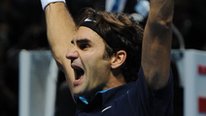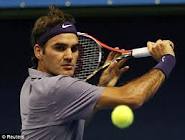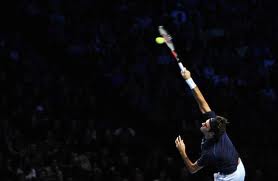Think perfect - Federer's precision mechanics are for you too!
My friend down at the tennis club managed to get tickets to Centre Court Wimbledon this year. I saw him on the telly from my couch. I waved but he didn’t see me. He was smiling and looking around the crowd. I think he was enjoying the perfect day.

The match we both watched was Nalbandian versus Federer. When I saw my friend when he got back he said what a disappointing match it was. He was right. Nalbandian was coming off a long injury lay off, looked a bit fat and resigned. Federer strolled through the three sets with no grunting, no sweating, no mutterings of frustration.
A game of errors
Tennis is principally a game of mistakes, either forced or unforced. True there are plenty of brilliant shots, and there are brilliant shot-makers in the game. However, tennis matches are effectively won by the player who makes the fewest mistakes. This sounds a bit tedious, especially when you look at a player like Federer, who is clearly a shot-maker. He doesn’t just get loads of balls in the court waiting for the opponent’s error.

Nailed slice
So, I’m just going to remind you before I go any further. Federer hardly makes any mistakes. That’s why he has won so much. When he does make a mistake, we are a little bit surprised, and, as my friend was also, disappointed. You don’t travel 1000 kms. to watch Federer to see him swish a forehand over the baseline. In the game against Nalbandian, there were one or two mistakes from Federer’s racket.
The key though, is that Federer uses these mistakes to get his range. He is one of the best users of mistakes you’ll ever see. With him, every shot is a perfect shot, a carefully calculated and executed brush stroke. If he misses, he winds up the mechanism like a Swiss watch, adjusts, and reboots his relentless array of strokeplay.

The big shot - the serve
Federer has an astonishing serve. It’s not a big serve, but he’s not a big man. Technically it is set up on a stable base. He commits himself to the spin and placement on first and second balls. Why oh why don’t we see more players copy these serve mechanics and skills? This, technically is a serve you can hit all day, you won’t get tired, and you can do anything you want with the ball. It is perfect.
Federer’s forehand is the best forehand that has ever existed. There’s a bit of wrist in it, so he’s always fiddling with the ball. It isn’t robotic, but little fine adjustments depending on his feet and tactical needs. If you want to see this forehand at its best, look at it when he’s going into his transition game – when he knows his opponent has hit a weak ball and he moves up the court. He completely cleans up any rubbish from his opponent. It’s perfect.
Federer’s backhand is a more contestedly disputed item, but this is mostly because you are comparing it to his other side, to the most stupendous, destructive forehand ever. Certain players, very, very few, have exposed Federer’s backhand set up, not the technique, please note, but the set up. Nadal in particular exposed this regularly. Federer has a touch backhand, a fizzing slice, a rolling, flicking topspin, a cracking top-of-the-bounce flat drive, all this hit all over the court with consummate ease. If you power spin balls into Federer’s backhand, like Nadal, make him stretch and defend, his timed attacking shots dry up. He doesn’t want to power it back, he wants to touch it back. However, Federer COULD power the ball. So often, against Nadal, he just didn’t. This is just a set-up problem, a strategic, and preparational one. Technically, Federer’s backhand is perfect.
Federer can volley. He isn’t a pathological volleyer. He doesn’t need to do it to expose his personality. However, I reckon that when you play him and you know he can play any shot at net, you then fear him coming forward, you fear his transition game. His movement, as all over the court, is a joy to behold. So is he at net. His touch is exquisite. When he’s at net, he’s really having fun with you. His volleys are perfect.

A question of language
For those of you non-linguists out there, Feder, in German, means, curiously, two things – a spring, as in a bedspring, or clock spring, or it can also mean a feather, a bird’s feather. How did such an astonishing player as this come into the world with such an apt name. Both these words typify his specialness, the lightness and the coil in all that he does.
All great careers come to an end, and Federer isn’t far from the end of his. He is a born crowd pleaser, he loves his public. I hope he’ll be seen in Seniors tennis too, but you really need to see him now, at the height of his powers. He may go back to where he came from – another planet.
